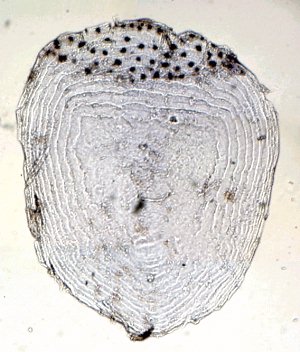 |
 |
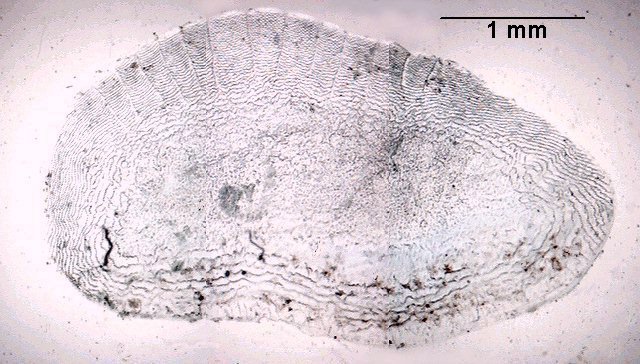
Another example of cycloid scale: sea bream.
|
|
|
||||
|
It's well known that children don't like to eat fish. Mainly whole fish because they are frightened to find some spines in them (many adults are wary too!). Deep-frozen fish fillets coated with breadcrumbs are more pleasant for them but when we ask a very young child to draw a fish, they risk drawing a rectangle because they have never seen a real fish! To summarize, children like fishes in aquaria not on their plates! |
| Maybe I know a means to reconcile children and fish (unless you know to the contrary!). How? By observing fish scales under the microscope. Fish have upon their skin, hard plates forming scales which have various functions. Firstly, they protect the skin from attacks by predators, parasites and other injuries. Scales are positioned one atop the next in such a way that they can slide one against the other: they form a sort of soft armored protection, which can be freely distorted when the fish is moving (like a coat of mail worn by medieval knights). But they probably also have a hydrodynamic function to reduce water friction and resistance to forward motion. | |
| There are four types of scales with numerous variations of each kind: Placoid, cosmoid, ganoid and the most frequently encountered; cycloid and ctenoid scales. Some fishes like sole have ctenoid scales on the 'eyed' side of their body and cycloid scales on the other side. |
| Examples of cycloid scales: Trout and smelt. | ||||
Scales are more
frequently transparent, but in some species scales can have pigmentation
dots, for example on rainbow trout (scale on the left below).
|
||||
| Scales have a particular feature: they possess concentric patterns looking like the tree rings you can see on cut tree trunks. ...But scales are permanent on fish skin: they don't fall like tree leaves so they can to be used to calculate a fishes age. But fish growth can be irregular (e.g. females stop growing while reproducing...) and a laboratory study of each species is necessary to correlate the rings with real age. If you mount scales on a slide and look through them toward a light source, you can see some iridescence (rainbow colors) because light is diffracted light by the scale rings. | ||||

Another example of cycloid scale: sea bream. |
||||
| The pictures below show some scales from various common species. | ||
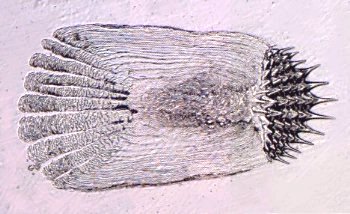 |
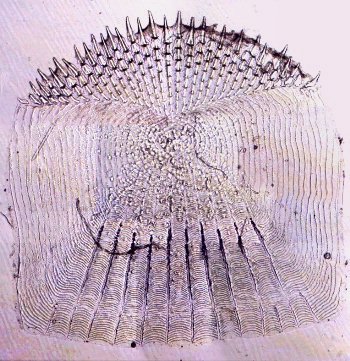 |
|
|
Scale on the right: sea perch. |
||
| It's not necessary to be a great fisherman to observe scales: when you go to your fishmonger to buy some fish (assuming you eat fresh fish at least once a year!) ask him to scrape a little 'skin' off the various species he sells. You can narrate to him a little story: that the observation of scales is the only way you have found to make your children eat fish .... | ||
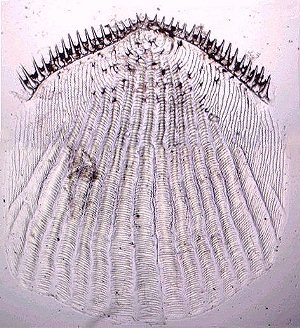 |
Another
example of a ctenoid scale: goby.
You can try looking at anchovy which
are small fish but their scales are very large!
|
|
| Note: All scale pictures above are montages of 4 to 8 images taken using a 2,5x objective. | ||
| Some species like blennies, don't have scales, but a slimy skin with brown and black spots: see picture below. These spots are of a size which can probably fluctuate according to nervous stimuli (like in squids): if the black spots are enlarged, the skin become darker to conceal itself on the dark sea bottom thus escaping its predators. If the red spots become enlarged its color mimics a brown sandy color ...It's for the same reason that fishes have a pale coloured belly: they escape predators coming from below, because they are less visible against the silvered surface of the sea. | |
 |
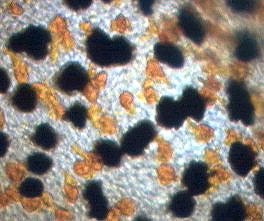 |
|
Above: detail of skin. |
|
| Scales are easy objects to mount. First, they must be well washed. I use the following process to remove fat traces or mucous: I stain the scales for some seconds with e.g. eosin or methylene blue (it's useful to see them better!), I shake them in a test tube filled with fresh water. In fact I use a full glass of water with only ONE small drop of detergent to wash the plates. (This works well with insects too, which are difficult to wet.) Rinse well three or four times, and you can mount the scales in glycerine jelly. Darkfield illumination works well when studying them too (e.g. sole scales, see images below). | |
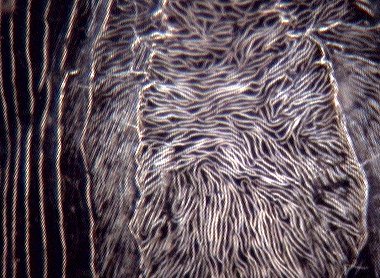 |
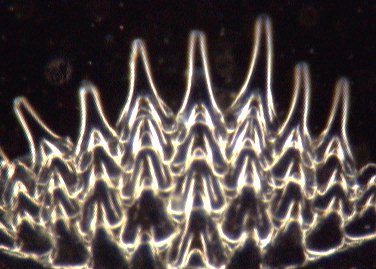 |
|
|
|
Microscopy
UK Front Page
All drawings and photographs © Jean-Marie Cavanihac 2001 Published in the January 2002 edition of Micscape Magazine. Please report any Web problems or offer general comments
to the Micscape
Editor,
Micscape is the on-line monthly magazine of the Microscopy
UK web
|